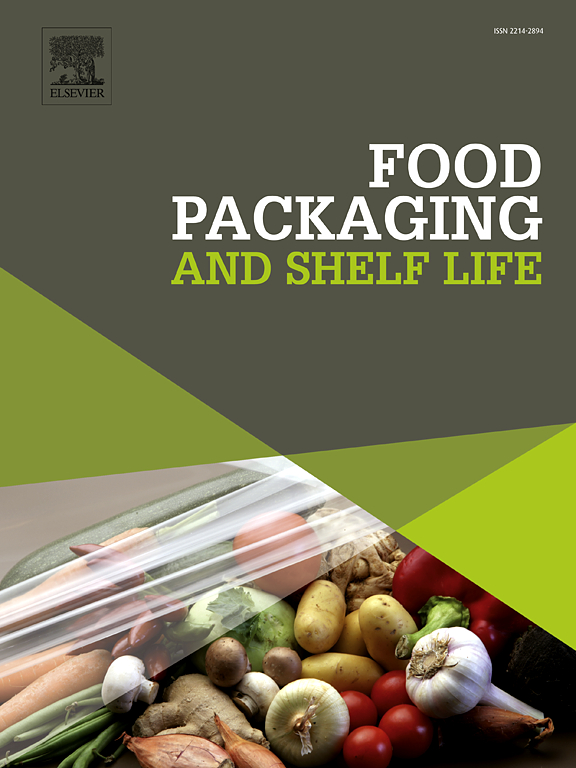Chitosan/MXene/ε-polylysine based biodegradable packaging films with synergistic photothermal antimicrobial properties
IF 10.6
1区 农林科学
Q1 FOOD SCIENCE & TECHNOLOGY
引用次数: 0
Abstract
Conventional food packaging often faces limitations due to their minimal antimicrobial effects and lack of degradability. Herein, Ti3C2TX MXene (MX) was employed as a template to load ε-polylysine (ε-PL) via electrostatic interactions (denoted as MX@PL). Then, the MX@PL was blended with chitosan (CS) through solvent casting method to fabricate degradable films (CMP films) with photothermal antibacterial properties. Under near-infrared laser irradiation (808 nm, 1.5 W/cm2), the temperature of CMP films rose from 24.53 °C to 74.28 °C within 3 min, which generated a large amount of heat leading to the death of bacterial cells by rupture, thus significantly boosting the antimicrobial effectiveness of films. Results demonstrated that CMP films inhibited Staphylococcus aureus and Escherichia coli by 99.85 % and 99.99 %, respectively. In addition, CMP films exhibited ultra-low oxygen permeability, which was beneficial for reducing food oxidation during storage. Moreover, the incorporation of MX@PL improved the biodegradability of the CMP films due to the increased hydrophilicity, while also enhancing their thermal stability, mechanical properties, and ultraviolet-visible shielding capabilities. These findings suggested that photothermal antibacterial CMP biodegradable films were promising for food preservation, reducing environmental pollution and preventing food waste.
壳聚糖/MXene/ε-聚赖氨酸基生物降解膜的协同光热抗菌性能
传统的食品包装往往面临的限制,由于其最小的抗菌效果和缺乏可降解性。本文以Ti3C2TX MXene (MX)为模板,通过静电相互作用(表示为MX@PL)加载ε-聚赖氨酸(ε-PL)。然后,将MX@PL与壳聚糖(CS)通过溶剂浇铸法制备具有光热抗菌性能的可降解膜(CMP膜)。在近红外激光(808 nm, 1.5 W/cm2)照射下,CMP膜的温度在3 min内由24.53℃上升到74.28℃,产生的大量热量导致细菌细胞破裂死亡,显著提高了膜的抗菌效果。结果表明,CMP膜对金黄色葡萄球菌和大肠杆菌的抑制作用分别为99.85 %和99.99 %。此外,CMP薄膜具有极低的透氧性,这有利于减少食品在储存过程中的氧化。此外,MX@PL的加入提高了CMP膜的亲水性,提高了CMP膜的生物降解性,同时也增强了它们的热稳定性、机械性能和紫外可见屏蔽能力。这些研究结果表明,光热抗菌CMP生物降解膜在食品保鲜、减少环境污染和防止食物浪费方面具有广阔的应用前景。
本文章由计算机程序翻译,如有差异,请以英文原文为准。
求助全文
约1分钟内获得全文
求助全文
来源期刊

Food Packaging and Shelf Life
Agricultural and Biological Sciences-Food Science
CiteScore
14.00
自引率
8.80%
发文量
214
审稿时长
70 days
期刊介绍:
Food packaging is crucial for preserving food integrity throughout the distribution chain. It safeguards against contamination by physical, chemical, and biological agents, ensuring the safety and quality of processed foods. The evolution of novel food packaging, including modified atmosphere and active packaging, has extended shelf life, enhancing convenience for consumers. Shelf life, the duration a perishable item remains suitable for sale, use, or consumption, is intricately linked with food packaging, emphasizing its role in maintaining product quality and safety.
 求助内容:
求助内容: 应助结果提醒方式:
应助结果提醒方式:


